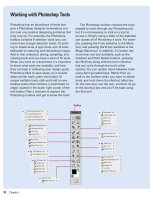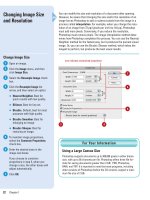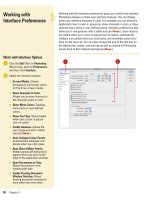Photoshop cs5 by steve Johnson part 18 pps
Bạn đang xem bản rút gọn của tài liệu. Xem và tải ngay bản đầy đủ của tài liệu tại đây (552.63 KB, 6 trang )
ptg
110 Chapter 5
Photoshop's traditional layers basically function like sheets of transpar-
ent acetate or clear plastic. Once created, they support all of
Photoshop's painting tools, as well as shape and gradient tools. While
traditional layers may start out transparent, they don't remain that way
for long. In fact, a layer can, over time, become a complicated mix of
non-transparent (the image), and transparent areas. It's also possible
you might want to make a selection out of that complicated image.
Photoshop knows this and gives you an easy way to create a selection
from a layer. If you want to move a selection, you can drag the selec-
tion marquee, even if the layer is hidden (New!).
Creating a Selection
from a Layer
Create a Selection from a Layer
Select the Layers panel.
Hold down the Ctrl (Win) or A
(Mac) key, and then click on the
image thumbnail of the layer you
want create into a selection. Be
sure you click on the image
thumbnail, not the layer name as
you would have in previous
versions.
The visible portions of the image
on the layer are created into a
selection.
IMPORTANT
Since Photoshop
creates the selection based on the
image information, there must be
transparent and non-transparent
areas within the image or the
command selects the entire layer
as if you had clicked the Select
menu, and then clicked All.
2
1
Selection based on the visible
portions of the layer.
1
2
From the Library of Wow! eBook
ptg
Chapter 5 Working with Layers 111
On the previous page, you learned how to create a selection based on
the image information within a layer. In addition to creating a selection
from a layer, Photoshop gives you the ability to instantly create a layer
from a selection. Creating layers from selections opens up all kinds of
opportunities for generating special effects. For example, you could
select an object from one layer, and then make a layer with that selec-
tion, or you could make a selection of just that portion of an image and
then apply a layer style to the new layer copy. The possibilities are end-
less, and part of the fun of using Photoshop lies in exploring those
possibilities. If you want to move a selection, you can drag the selec-
tion marquee, even if the layer is hidden (New!).
Creating a Layer from
a Selection
Create a Layer from a Selection
Select the Layers panel.
Click on the layer containing the
information you want to convert
into a layer.
Select an area of the image using
any of Photoshop's selection tools.
Press Ctrl+J (Win) or press A+J
(Mac) to make a copy.
Photoshop converts the selected
area into a new layer, and places
that layer directly above the active
layer.
4
3
2
1
1
2
Select the red ant
Copy made from selection
3
4
Did You Know?
You can make a copy of all elements
within a layer.
Select the layer in the
Layers panel, and then click Ctrl+J
(Win), A+J (Mac). Since there are no
selections, Photoshop creates a copy
of the entire layer.
You can make copies of layer objects
without a selection.
To ma ke a copy of
a layer that contains an object, select
the layer in the Layers panel, select the
Move tool, hold down the Alt (Win) or
Option (Mac) key, and then click and
drag (in the document window).
From the Library of Wow! eBook
ptg
112 Chapter 5
The Background layer serves a unique function in Photoshop. Since
some layout programs do not support Photoshop's multiple layer and
transparency capabilities, a final image must sometimes be converted
into a background layer by a process called flattening. When an image
is flattened, all of the document’s layers are compressed into a single
layer in the Layers panel, named Background. That means no more lay-
ers, no more transparency, and no more control. Background layers are
a necessary evil because Photoshop does not stand alone, and it's
sometimes necessary to move images from Photoshop into other appli-
cations. However, there are times you may start with an image that only
contains a Background layer (for example, when working with original
images from a digital camera, scanned images, or images from a photo
CD or DVD) and you want to apply transparency, blending modes, or
other adjustments to it that cannot be applied to a Background layer. In
that case, you will need to convert the Background into a traditional
Photoshop layer.
Converting a
Background into
a Layer
Convert a Background
Select the Layers panel.
Double-click on the Background to
open the New Layer dialog box.
◆ You can also click the Layer
menu, point to New, and then
click Layer From Background.
Rename the layer in the Name box
(leave the other options at their
default values).
Click OK.
The Background is converted into
a traditional layer.
4
3
2
1
1
2
3
4
New layer from
a background
From the Library of Wow! eBook
ptg
Chapter 5 Working with Layers 113
Convert a Multi-Layered
Document into a Background
Select the Layers panel.
Click the Layers Options button,
and then click Flatten Image.
The multi-layered document is
compressed into a single-layer
Background.
2
1
1
2
Multiple layers compressed into a
single-layer Background
6 separate layers plus the Background
Did You Know?
You can create a composite image of a
multi-layered document without flat-
tening the image.
Create and select a
new layer, and then hold down the Alt
(Win) or Option (Mac) key. Now, go to
the Layers panel, click the Layers
Options button, and then click Merge
Visible. Photoshop creates a composite
of all the visible layers in the new layer.
You now have the control and flexibility
of a multi-layered document, along
with a separate composite layer.
Control gives you the confidence to be
more creative.
See Also
See “Using Merge Layer Options” on
page 116 for more information on how
to merge two or more layers without
flattening all the layers.
From the Library of Wow! eBook
ptg
114 Chapter 5
When you work on multi-layered documents, it's important to under-
stand the options Photoshop gives you to control image information. For
example, working on a document that contains 20 layers is a difficult
proposition. Fortunately, Photoshop gives you complete control over the
document; everything from layer names to locking pixel information is
available in Photoshop's bag of image-control tricks. For example,
when linking two layers together, you can move or resize the layers at
the same time, thus saving valuable time. Let's explore some of the
ways you can control image information with the Layers panel.
Controlling Image
Information Using the
Layers Panel
Control Image Information
Select the Layers panel, and then
use one of the following options:
◆ Layer Name. To name a layer,
double-click on the current
layer name, type a new name,
and then press Enter (Win) or
Return (Mac).
◆ Show/Hide. To te mp oraril y hid e
or show a layer (make its
contents invisible or visible in
the document window), click
the Eyeball button, located in
the Show/Hide box.
◆ Linking. To li nk tw o or more
layers, hold the Shift key and
click the layers you want to
link, and then click the Link
Layers button (located at the
bottom left of the Layers panel).
The link icon indicates the
layers are linked. Linking lets
you move or resize the layers
as a unit.
◆ Locking. The four available
locking options are: Lock
Transparent Pixels, Lock Image
Pixels, Lock Position, and Lock
All.
◆ Stacking Order. To chang e the
position of a layer in the stack,
drag the layer up or down. A
dark line appears as a visual
cue to indicate the new layer
location.
1
Lock options
Linking
Stacking order:
the position of
the layers within
the panel.
Layer name
Show/Hide
From the Library of Wow! eBook
ptg
Chapter 5 Working with Layers 115
Photoshop documents typically contain multiple layers. One web survey
concluded that Photoshop designers tend to create documents with an
average of 14 layers. Controlling layers is an important aspect of
design, because the more control you maintain, the more organized you
are, and the better your design will be. But what about controlling lay-
ers across multiple documents? For example, you're working on a
design, and you need access to some additional image information. The
only problem is that the additional information is located in another
Photoshop document. Photoshop gives you the ability to move layers
between open documents.
Moving Layers
Between Documents
Move Layers Between
Documents
Open the documents in which you
want to move layers.
To have mor e tha n one doc um ent
in view, click the Window menu,
point to Arrange, and then click
Cascade or Tile.
Click on the document containing
the layer you want to move.
Drag the layer from the Layers
panel into the window of the
receiving document.
Photoshop creates a new layer
with a copy of the image
information from the other
document.
4
3
2
1
Drag moon
layer here
3
4
Moon layer
New layer from
donor document
Did You Know?
You can control the position of the
moved layer.
Hold down the Shift key
while dragging the layer into the other
document. Photoshop aligns the new
layer to the center of the receiving
document.
You can move selected portions of a
layer.
Select the area you want to
move, click the Move tool, and then
drag the selected area directly from
the document window into the window
of the receiving document.
From the Library of Wow! eBook









